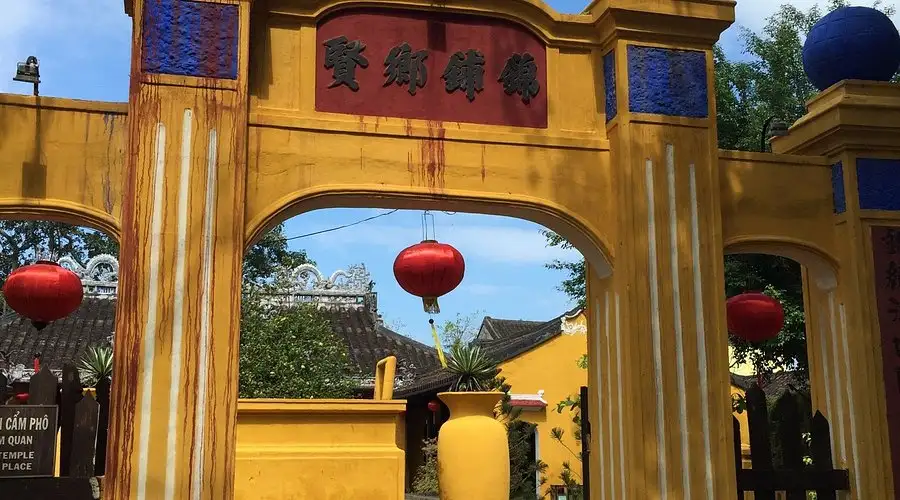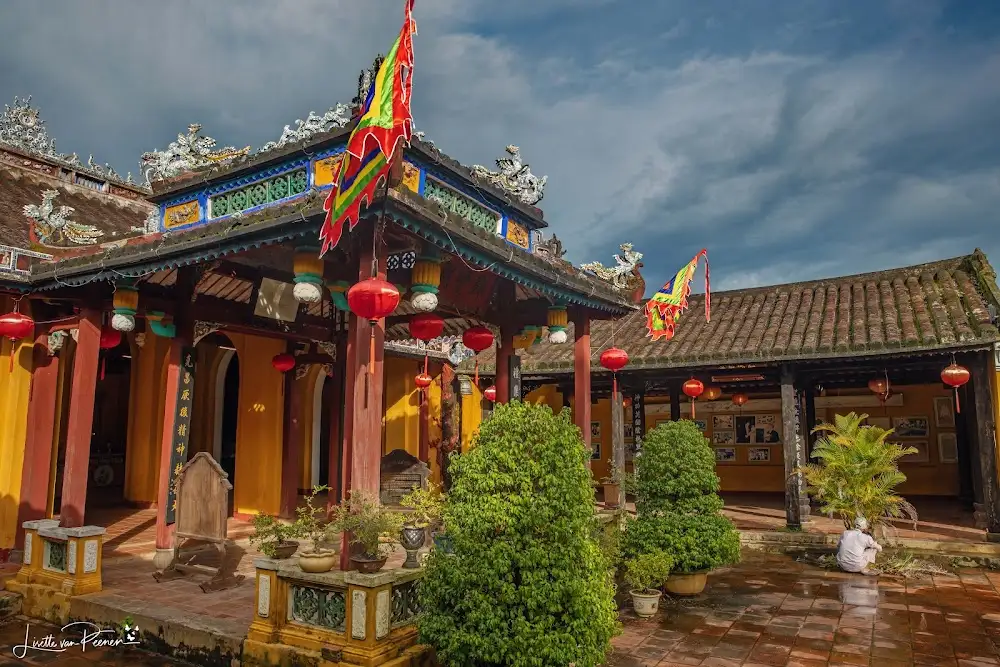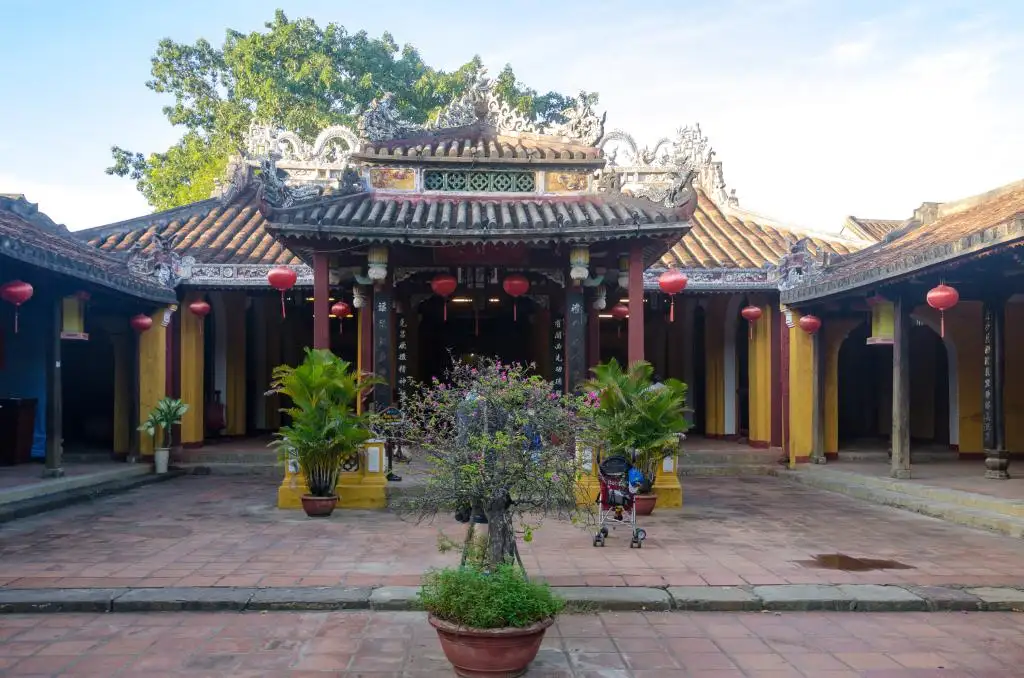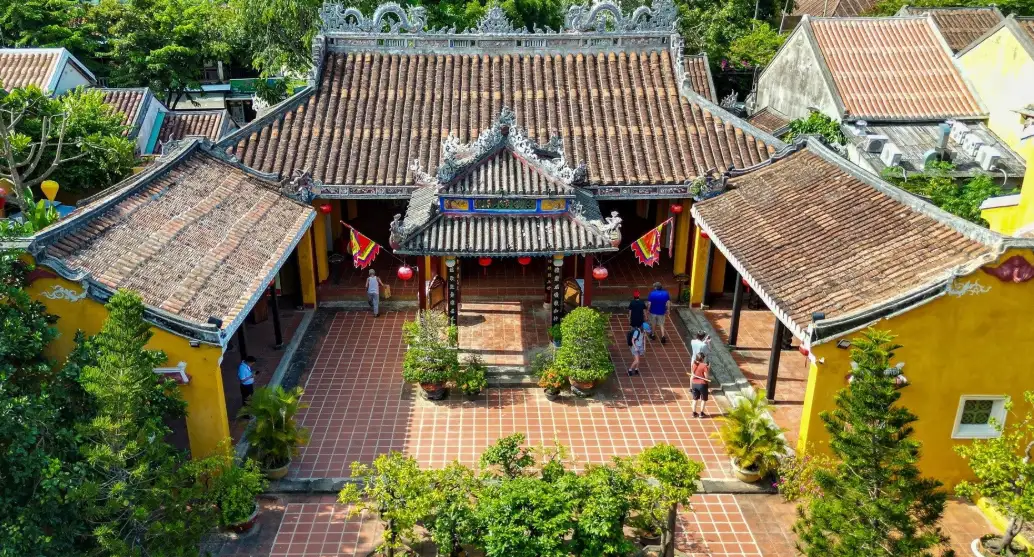Discover the heritage of Cam Pho Communal House Hoi An
Located in the heart of Hoi An Ancient Town, the Cam Pho Communal House is a historical and cultural gem that encapsulates the essence of Vietnam’s traditional communal living. Built during the 15th century, this well-preserved structure stands as a testament to the close-knit communities of the past and serves as a spiritual and social hub for locals and visitors alike. This article explores the history, architecture, and cultural significance of Cam Pho Communal House while providing tips for travelers eager to discover its beauty.
A historical landmark in Hoi An

Cam Pho Communal House Hoi An is one of the oldest communal houses in Hoi An, with its origins tracing back to the 15th century. It was constructed during a time when the Cam Pho ward was a bustling part of the Hoi An trading port, which flourished thanks to its strategic location on the Thu Bon River. This communal house became the heart of the local community, serving both spiritual and practical purposes.
The role of Communal Houses in Vietnamese culture
In Vietnamese villages, communal houses were more than just physical structures. They were the spiritual and administrative centers of community life. The Cam Pho Communal House was a place where villagers gathered to honor their ancestors, worship local deities, and celebrate festivals. It was also where important decisions were made, disputes resolved, and communal bonds strengthened.
During the Nguyen Dynasty, the communal house underwent significant renovations, adding ornate architectural elements and reinforcing its cultural importance. Despite facing natural wear and tear over centuries, it has been meticulously preserved, standing today as a cultural landmark that continues to attract visitors from around the world.
Hoi An’s multicultural influence
The history of Cam Pho Communal House is intertwined with Hoi An’s multicultural past. As a key trading port, Hoi An was a melting pot of Vietnamese, Chinese, Japanese, and even European influences. These cultural exchanges are reflected in the communal house’s design, rituals, and even the stories associated with it.
Architectural marvels of Cam Pho Communal House
The architecture of Cam Pho Communal House is a captivating blend of functionality, symbolism, and artistry. Every detail, from the layout to the intricate carvings, reflects the cultural and spiritual values of the community.

A harmonious layout
The communal house is built following ancient Vietnamese principles of harmony and balance, which aim to create a space that resonates with both the physical and spiritual world. The layout includes a spacious courtyard, a main worship hall, and smaller side chambers. The courtyard serves as an open area for communal gatherings and festival celebrations, while the worship hall is the sanctum where spiritual rituals take place.
Intricate carvings and motifs
One of the most captivating features of the communal house is its intricate woodwork. The columns, beams, and altars are adorned with elaborate carvings of dragons, phoenixes, and floral patterns, symbolizing prosperity, longevity, and harmony. The roof tiles, painted in rich shades of red and gold, are arranged to form mythical creatures, adding to the grandeur of the structure.
Symbolism in design
Each element of the communal house carries symbolic meaning. For example, the dragon motifs on the roof represent power and protection, while the phoenix signifies renewal and grace. These symbols were carefully chosen to reflect the aspirations and beliefs of the Cam Pho community.
Multicultural aesthetic
The communal house’s design also incorporates elements of Chinese and Japanese architecture, such as the curved roof edges and the use of lacquered wood. These features highlight the cultural interactions that were integral to Hoi An’s history as a trading hub.
Cultural and spiritual significance
At the heart of Cam Pho Communal House lies its role as a spiritual and cultural cornerstone for the community. It is not merely a historical site; it is a living space that continues to resonate with the traditions and practices of the local people.

Ancestral worship is a deeply rooted tradition in Vietnam, and Cam Pho Communal House plays a pivotal role in this practice. The main altar is dedicated to local deities and ancestors, adorned with offerings such as fruits, incense, and flowers. Visitors can witness or even partake in these rituals, gaining a deeper understanding of Vietnamese spiritual life.
The communal house is the focal point of several annual festivals, the most notable being the Lunar New Year (Tet) and the Mid-Autumn Festival. During these events, the communal house becomes a vibrant center of activity, with traditional performances, lion dances, and elaborate processions. These festivals are not only a treat for the eyes but also an opportunity to experience the warmth and hospitality of the Cam Pho community.
In addition to its spiritual functions, the communal house serves as a venue for community meetings, educational events, and cultural workshops. This dual role highlights its enduring importance as a space for both reflection and connection.
Getting to Cam Pho Communal House
Reaching Cam Pho Communal House is a straightforward and enjoyable journey, thanks to its convenient location near the heart of Hoi An Ancient Town. Whether you prefer walking, cycling, or riding in a traditional cyclo, there are multiple ways to arrive at this cultural landmark. Below are detailed directions and tips to help you plan your visit.
Walking: A scenic stroll through Hoi An
For those staying within the Ancient Town area, walking to Cam Pho Communal House is both practical and delightful. Start by heading north on Tran Phu Street, one of Hoi An’s main thoroughfares lined with historic buildings and charming shops. Continue until you reach the intersection with Nguyen Thi Minh Khai Street. Turn left onto Nguyen Thi Minh Khai and walk straight for approximately 500 meters.
As you approach, keep an eye out for the communal house’s distinct traditional architecture, including its tiled roof and intricately carved woodwork. Located at 52 Nguyen Thi Minh Khai, the communal house is easily recognizable and makes for a rewarding destination at the end of your stroll. Walking not only allows you to explore the local streets but also gives you a chance to soak in the vibrant atmosphere of Hoi An.
Cycling: An eco-friendly option

Hoi An is well-known for its bicycle-friendly environment, making cycling an excellent choice for getting to Cam Pho Communal House. Rent a bicycle from one of the many rental shops in the town center, and head north on Tran Phu Street. Upon reaching the intersection with Nguyen Thi Minh Khai, turn left and continue straight for about 500 meters. The ride to 52 Nguyen Thi Minh Khai should take no more than 10 minutes, depending on your pace.
Cycling not only saves time but also offers a fun way to explore Hoi An’s picturesque streets. As you pedal through town, you’ll pass by lantern-lit shops, quiet alleys, and small cafes, making the journey as enjoyable as the destination itself.
Motorbike taxi (Xe Ôm): Quick and convenient
If you’re short on time or prefer a quicker ride, consider hiring a motorbike taxi, locally known as xe ôm. You can easily find xe ôm drivers around Hoi An Ancient Town, especially near popular tourist spots. Let the driver know you want to go to Cam Pho Communal House at 52 Nguyen Thi Minh Khai, and they will take you directly there.
The ride is short and should take no more than 5 minutes, depending on traffic conditions. Be sure to agree on the fare beforehand, as most drivers are open to negotiation. This option is ideal for visitors who value efficiency and want to experience the local mode of transportation.
Cyclo: A traditional and leisurely ride
For a truly unique way to travel, hop on a cyclo, the traditional Vietnamese pedicab. Cyclo rides are a leisurely option, allowing you to enjoy the sights and sounds of Hoi An at a relaxed pace. You’ll find cyclo drivers offering their services around the Ancient Town.
Negotiate the fare with your driver before the ride and request a trip to Cam Pho Communal House at 52 Nguyen Thi Minh Khai. The journey should take around 10-15 minutes, depending on traffic and your driver’s pace. As you ride, you’ll have the opportunity to appreciate Hoi An’s historic streets and take in the tranquil charm of the town.
Visiting Cam Pho Communal House

Exploring Cam Pho Communal House is a must for any traveler to Hoi An. Its serene ambiance, artistic beauty, and cultural richness make it a highlight of the ancient town.
Practical information
- Location: Cam Pho ward, Hoi An Ancient Town, Quang Nam Province.
- Opening Hours: 8:00 AM to 5:00 PM daily.
- Admission: Included in the Hoi An Ancient Town entrance ticket.
What to expect
- Guided tours: Many tours of Hoi An include a visit to Cam Pho Communal House, offering insights into its history and cultural significance.
- Cultural performances: If you’re lucky, you might catch a traditional music or dance performance during your visit.
- Photography opportunities: The intricate architecture and serene setting provide a perfect backdrop for photography enthusiasts.
Best time to visit: The communal house is particularly enchanting during the Hoi An Lantern Festival, held on the 14th day of each lunar month. The entire town is aglow with lanterns, and the communal house is adorned with additional decorations, creating a magical atmosphere.
Cam Pho Communal House is more than a historical monument; it is a living embodiment of Vietnam’s cultural and spiritual heritage. Its timeless beauty, vibrant festivals, and profound traditions offer a unique window into the heart of Hoi An. For a truly enriching experience, let Bliss Hoi An Beach Resort and Wellness guide you through the wonders of Cam Pho Communal House and beyond. Explore the ancient streets of Hoi An, immerse yourself in local traditions, and create memories that will last a lifetime.









